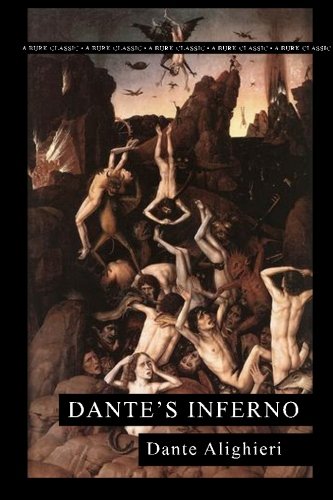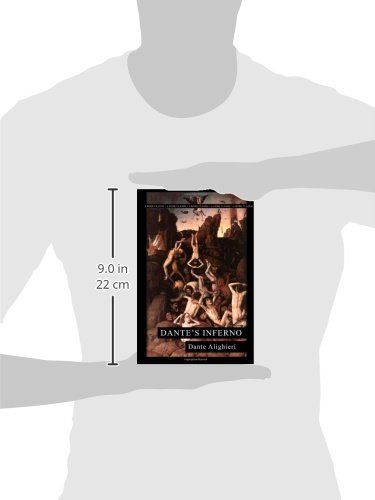Hey there, book lovers! Ever wondered what a journey through Hell looks like? Well, buckle up because today, we’re reviewing Dante’s Inferno. It’s packed with historical and cultural references, mind-bending symbolism, and unforgettable character interactions. Get ready for an honest and entertaining take on this classic!
In a nutshell
Genre: Epic Poetry, Allegory
Author: Dante Alighieri
Dante’s Inferno is a classic tale that kicks off Dante Alighieri’s Divine Comedy trilogy. It’s an epic poem that takes you on a wild tour through the nine circles of Hell. Guided by the ghostly poet Virgil, our man Dante encounters historical figures, mythological beasts, and some bizarre punishments for sinners. Major themes include divine justice, morality, and redemption. It’s like a medieval horror road trip—with poetry!
Journey through Hell: A Wild Ride with Dante’s Inferno
So, you’ve got Dante’s Inferno in your hands, and you’re ready to take a wild trip through Hell. Let me tell ya, it’s one heck of a journey. I mean, it’s not every day you get to walk through Hell with a personal guide. My buddy Bob and I decided to read this classic and, boy, were we in for a treat!
First thing’s first, the imagery. Dante’s descriptions are like a horror movie, but in book form. Each circle of Hell has its own unique flavor of terror. It’s dark, it’s eerie, and it’s fantastically inventive. I could almost feel the heat and smell the brimstone while reading it in my backyard, BBQing hotdogs. That’s one way to get into the spirit, right?
But let’s talk about the characters. Dante himself is a bit of a scaredy-cat, but can you blame him? He’s walking through Hell! His guide, Virgil, is the real MVP. Strong, wise, and calm. Kinda like that one friend who always knows the best way out of an escape room. Their dynamic makes the journey all the more interesting.
Now, for the downside. The language. It’s old, it’s poetic, and sometimes it’s hard to understand. I had to Google a bunch of references to get through it. Bob, on the other hand, gave up halfway and went back to his comic books. But if you’re into deep, symbolic tales, you’ll love it.
Ready to take the plunge? Great! Next up, we’ll talk about the historical and cultural references in Dante’s Inferno. It’s like finding Easter eggs in an ancient manuscript!
Historical and Cultural References in Dante’s Inferno
Dante’s Inferno isn’t just a wild trip through Hell—it’s a treasure chest of historical and cultural references! Imagine you’re at a party, and Dante walks in, name-dropping famous folks like a pro. His old-school networking game is strong!
One of the things that stand out is his beef with political figures. Dante has no chill pointing fingers at corrupt leaders, like Pope Boniface VIII. It’s like Dante saying, “You thought you could escape? Think again!”
Then there’s the Greek mythology thrown in the mix. You’ve got Minos, who’s not just a guy with a cool name, but the judge of souls. It’s like Dante decided to have a Greek-themed party in Hell.
And who could forget Virgil? This guy is Dante’s main guide and gives off major mentor vibes. Virgil’s there to show the ropes, making it a bit like Gandalf leading Frodo. Their bromance is strong!
Dante also throws in some medieval pop culture. Back then, everyone knew the juicy gossip around these characters. He mentions figures like Ulysses and Brutus. Today, it’d be like name-dropping celebrities at a dinner table.
The depth of Dante’s references is insane. It’s a blend of history, mythology, and his personal vendettas. If you ever wondered what the medieval version of a gossip magazine looked like, this is it.
Now that we’ve raved about the historical and cultural goodies, let’s get ready to plunge into the fascinating world of Symbolism and Themes. Trust me, it’s going to be a wild ride!
Symbolism and Themes in Dante’s Inferno
So, there I was, sipping my coffee and flipping through the pages of Dante’s Inferno. One thing that jumps right out is all the symbolism. It’s like Easter eggs in a Marvel movie but, you know, with more fire and brimstone. The big one? The journey itself. Dante’s trip through Hell is actually a metaphor for the soul’s journey toward God. Heavy stuff, right?
Another strong symbol is the light and darkness. In the Inferno, darkness dominates, showing the absence of God and goodness. It’s like when my Wi-Fi goes out—utter despair! Also, the three beasts Dante encounters in the beginning symbolize different sins: lust, pride, and greed. Talk about a triple threat! Each one blocks his path, really driving home that getting to Heaven ain’t gonna be an easy stroll in the park.
Then there’s all those circles of Hell. Each level represents different sins and their punishments. It’s like a macabre layer cake. Gluttons are stuck in a filthy muck, while the violent are boiling in blood. Charming, right? Dante’s clever like that, using the geography of Hell to highlight the idea of divine justice. The further down you go, the worse the sin. So no free passes here—everyone gets their just desserts.
Keep an eye out for symbolic characters like Virgil, who represents reason and human wisdom. Meanwhile, Beatrice symbolizes divine love and grace. It’s a good reminder that we need both to make it through tough times.
But enough about symbols and themes. Let’s get to the juicy part: character development and interactions. You won’t want to miss this!
Character Development and Interactions in Dante’s Inferno
Reading Dante’s Inferno feels like getting sucked into a real-life soap opera… in Hell. The characters Dante meets on his journey are as complex as my grandma’s knitting patterns. Dante’s development from a lost soul to a stern judge of the damned is just fascinating. Seriously, by the end, you’ll want to high-five Virgil for being the ultimate tour guide.
Dante himself is quite the character. At first, he is scared and confused. I mean, who wouldn’t be? I’ve been scared of haunted houses, so imagine Hell! But as he continues his journey, we see him become more confident and judgmental. His empathy fades, and his resolve strengthens. It’s like watching someone finally grow up during a road trip from Hell. Literally.
Then there’s Virgil. The ultimate bro. Virgil’s patience with Dante makes you think he deserves a Nobel Peace Prize. He’s wise, calm, and cool under pressure. He guides Dante through complex situations and acts as the voice of reason. Dante might have jumped into a pit of despair without Virgil’s serene influence. Their interactions range from mentor-student to a buddy-cop duo navigating Hell’s circles.
Let’s not forget the various souls Dante meets. Their stories are tragic, horrific, and sometimes downright relatable. They help paint a vivid picture of sin and consequence. But over time, Dante becomes less moved by their stories and more critical of their choices. The characters he meets all contribute to his transformation.
So, would I recommend Dante’s Inferno? Absolutely! It’s a character-driven journey that will leave you grateful for your relatively boring life.
Conclusion
Total honesty here folks—Dante’s Inferno is a wild ride through Hell. The imagery? Mind-blowing. You’ve got your circles of Hell, each nastier than the last. Symbols like light, darkness, and those creepy beasts will haunt your dreams. Oh, and the characters? Dante and Virgil make quite the duo. It’s like a buddy cop movie but with more eternal damnation.
Sure, the old poetic language is a bit of a brain-buster. You might need a translation to keep up. But, trust me, it’s worth the effort. The historical and cultural references are pure gold! Political figures, Greek mythology, and even medieval pop culture get a shout-out. It’s like a big ol’ Easter egg hunt for book nerds.
In short, if you’re up for a challenging yet rewarding read about divine justice and redemption, Dante’s Inferno is your jam. Just don’t forget to pack some mental snacks for the journey. That concludes the review, folks. Happy reading!



